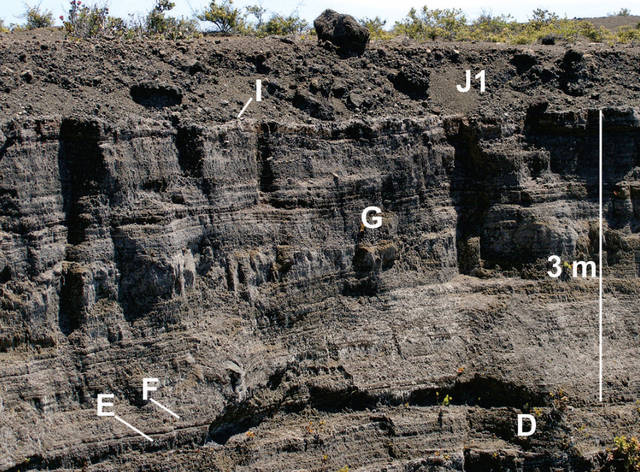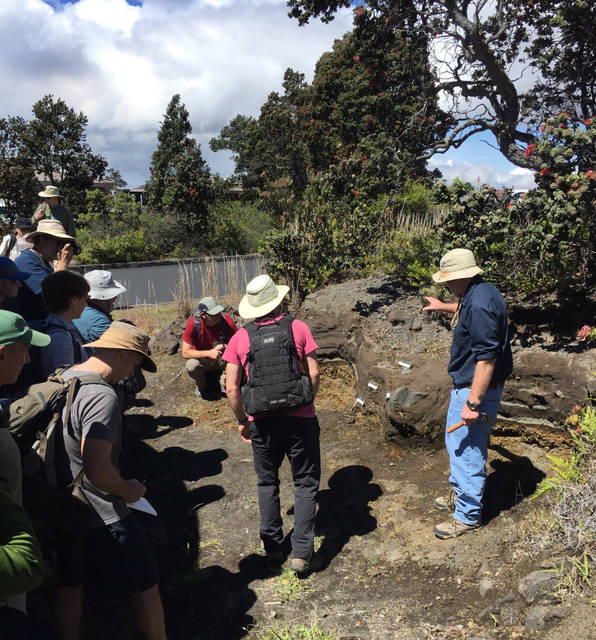Sometimes you just have to sit down and do it. Everyone is faced with this challenge at one time or another and scientists are no exception. Our research into the explosive history of Kilauea Volcano came to just such a head earlier this year.
Sometimes you just have to sit down and do it. Everyone is faced with this challenge at one time or another and scientists are no exception. Our research into the explosive history of Kilauea Volcano came to just such a head earlier this year.
Geologists often use a nearby geographic feature to name notable deposits such as formations. For example, all the explosive deposits produced by Kilauea between about 1500 and the early 1800s have been lumped under the name Keanakakoi Tephra (tephra is a term for any material exploded from a volcano.)
The name Keanakakoi was used, because good outcrops of the deposits are found near the crater of that name in Kilauea caldera. That name was first applied to the tephra deposits 80 years ago, and it has utility today when geologists are speaking in general terms about that period of time.
But the Keanakakoi Tephra contains many deposits, each of which was produced by a different eruption or a series of back-to-back similar eruptions. To study such specific eruptions, the term Keanakakoi Tephra is too general. What’s more, the variety in types of explosive activity is broad and of great importance in unraveling what happened and how it happened.
Keanakakoi Tephra is thus a wastebasket term — useful as a wastebasket, but we geologists really want to know what is in the basket.
We’ve limped along, using colorful terms for some of these subdivisions of the Keanakakoi. Names such as “mystery unit,” “footprints ash,” “layer 6 scoria,” “basal reticulite,” “golden pumice,” “eastern pumice,” and “unit H” have become the beloved jargon of the in-group studying the Keanakakoi. These names may never go away completely, but as more scientists tackle research issues in the Keanakakoi, a more systematic nomenclature became desirable. Something had to be done to clean up the mess.
a University of Hawaii at Manoa professor and a USGS Hawaiian Volcano Observatory geologist reached this conclusion during lunch while attending a geophysical meeting in San Francisco last December. They decided then and there to do something about it.
Pooling their expertise, the UH and HVO scientists developed a new nomenclature that is simple and reflects the various processes that formed the different deposits. They couldn’t use geographic names, as is the norm in geology. There simply aren’t enough suitable names around the caldera for what ultimately became a 12-unit classification, with some of the units subdivided still more.
Instead, they opted for a nomenclature that instantly allows a beginner to tell which of two units is the older. The units range from a to L, in order of decreasing age. Unit a was erupted in about 1500 and the four subdivisions of unit L (themselves in temporal order, L1 to L4) in the early 1800s. Letters, rather than numbers, were used to avoid confusion with an earlier numbered nomenclature that never really took off.
There’s been predictable pushback: the new terms lack color, are too hard to remember and too disruptive to old thinking, are not descriptive (as if “mystery unit” or “unit H” is descriptive!). But c’est la vie, that’s life. We think that, once the shock is over, the new nomenclature will make things easier for future researchers.
Eruption style and intensity that produced the Keanakakoi Tephra are exceptionally diverse for a basaltic shield volcano. The new nomenclature takes this diversity into account. The boundaries between units conform to important changes in eruption style and, commonly, to different directions the explosion debris was dispersed.
Maps of the different units show that their vents moved around in the caldera, sometimes shifting locations hundreds of meters in only a few years. Varying mixtures of steam from heated groundwater and volcanic gas powered many of the explosions, steam alone powered others, and at least four explosions were probably driven by volcanic gas only.
The caldera was a dynamic place during the 300-plus years just before written history began at Kilauea (in 1823), and the newly defined subdivisions of the Keanakakoi Tephra help us understand this energetic and dangerous time better than did the previous terminology. So, out with the old and in with the new!
Volcano Watch is a weekly article and activity update written by U.S. Geological Survey Hawaiian Volcano Observatory scientists.
Volcano activity Updates
This past week, Kilauea Volcano’s summit lava lake level fluctuated in concert with summit inflation and deflation, ranging about 105-125 feet below the vent rim. On the East Rift Zone, the 61g flow remained active, with lava entering the ocean near Kamokuna and surface breakouts downslope of Puu Oo. Widening cracks and slumping on the Kamokuna lava delta indicate its instability and potential for collapse. The 61g flows do not pose an immediate threat to nearby communities.
Mauna Loa is not erupting. During the past week, small-magnitude earthquakes continued to occur beneath the volcano, primarily in the south caldera and upper Southwest Rift Zone, at depths less than 3 miles. Additional deeper events (3-8 miles) occurred beneath the upper west and southeast flanks of the volcano. GPS measurements continue to show deformation related to inflation of a magma reservoir beneath the summit and upper Southwest Rift Zone. No significant changes in volcanic gas emissions were measured.
One earthquake with three or more felt reports occurred on Hawaii Island during the past week: At 3:52 p.m. on Aug. 29, a magnitude-3.8 earthquake located 7 miles beneath Hawaiian Ocean View Estates.
Visit https://volcanoes.usgs.gov/hvo for past Volcano Watch articles, volcano updates and photos, recent earthquake info, and more. Call for summary updates at 967-8862 (Kilauea) or 967-8866 (Mauna Loa). Email questions to askHVO@usgs.gov.


